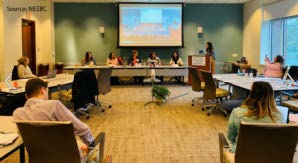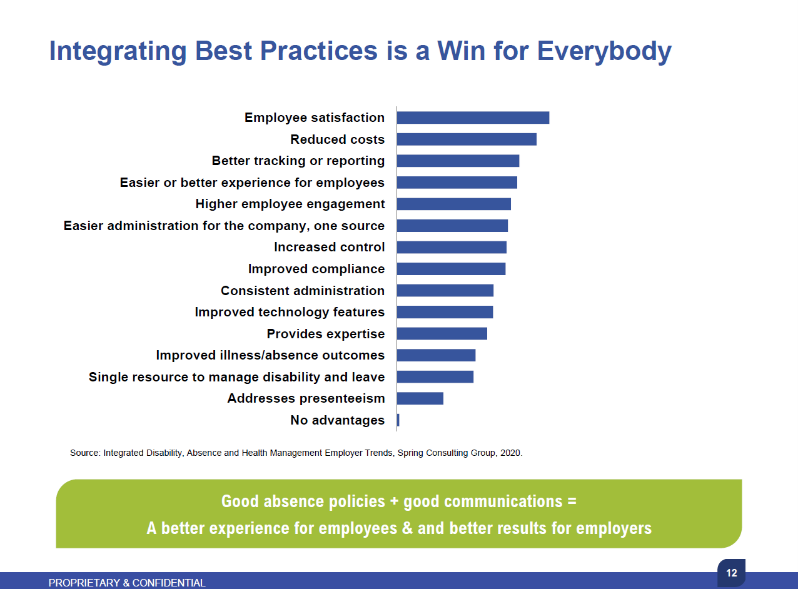In this podcast episode by the International Risk Management Institute (IRMI), Prabal Lakhanpal, Vice President at Spring, explains in a Snap Talk the basics of captive insurance.
Featuring research and insights form Spring, check out this article in BenefitsPRO explaining that where federal lawmakers have failed, states and employers have been stepping into the gap.
A Recap of NEEBC’s Beyond the Basics (Level 2) Event
Last week I had the honor of presenting at the New England Employee Benefits Council (NEEBC)’s Health & Welfare: Beyond the Basics (Level 2) event. The event provided great insights into how employers can adapt their corporate culture and provide strong benefits to attract and retain top-tier talent. Sessions focused on the following four critical areas of health and welfare: healthcare, data analytics, lifestyle accounts, and employee absence.

- Healthcare
David Chamberlain from Brown & Brown clarified the difference between health and wellness and steps employers can adopt to promote preventative care. He later dove into the differences and advantages of discount analysis verses repricing and how this all ties into pharmaceutical needs. Finally, he outlined the landscape of Pharmacy Benefit Managers (PBMs) and how new disrupters such as Amazon Pharmacy are able to provide pharmaceutical capabilities for people with and without insurance.
- Data Analytics
Mary Delaney from Vital Incite explored the need for data when developing benefits strategies. She explained how data such as age, gender, medication patterns, likeliness of hospitalization and other indicators are essential when developing a health/medical insurance plan. Lastly, she explains how this data can be collected through employee needs surveys and analyses of national health data trends.
- Lifestyle Accounts
Firstly, Jennifer Aylwin from Vertex Pharmaceuticals gave a short background on lifestyle accounts (LSAs) and how they can appeal to a range of employee needs. Due to the COVID-19 pandemic, many employees are now working in a hybrid or remote setting, and LSAs are a good practice to keep those employees content and engaged. She ended her presentation with an exercise where the audience was able to develop a business case for leadership consideration of LSAs.
- Absence

As for absence management, I had the pleasure of presenting on this topic. I started by exploring some of the benefits of adopting integrated absence management policies, such as reducing administrative costs and fostering a positive corporate culture where employees feel valued. I ended by showing how strong absence policies paired with effective communication of those policies have proven to provide a better experience for employees and greater workplace efficiency.
All in all, it has been great finally being able to see so many familiar faces in person again. As we adjust to a post-pandemic life, it is essential that we implement health and welfare strategies that match the need of employees currently. Keep an eye out for Spring at upcoming NEEBC events here.
Our Managing Partner, Karin Landry, presented on climate risk at the 2022 RIMS Riskworld Conference. Check out this session summary from Business Insurance.
The higher education sector is faced with unique risks and expectations. In this Boston Business Journal article, our Managing Partner, Karin Landry, highlights key points from a Future of Higher Education event, pointing out risk management considerations for this field.
Change is the only constant in life.
Heraclitus (Greek philosopher)
If what Heraclitus said is true, and I believe it is, then why is it so hard for us – both people and organizations – to accept change and realign goals and objectives? We could cite deep routed tradition at universities and colleges, pillars of success permeated from board chairs at non-profits, family values passed from prior generations at partnerships, or implanted views from shareholders. But whatever it is, the things that once got us climbing toward the top may also be what is holding us back from reaching the next summit.
As I refine my lens as a thought leader in employee health and welfare programs, I believe traditional change philosophies may be outdated. As organizations continue to evolve and grow, those corporate flaws that once reflected in the mirror as fine lines are becoming deeper. Workers and customers are redefining their definition of perfection and demanding more action, transparency, and change. Alas, our approach to organizational change requires a facelift, or maybe just a makeover.
I think Martha Freymann Miser, PhD summarized things well in a piece called Three Myths of Change. In that piece she highlights 3 myths of change, which reflect some outdated philosophies of change management:
- Change Starts at the Top
- Prediction is Possible
- Control Equals Efficiency

Myth Makeovers
Although it is poetic to think that change starts at the top, I think it’s more accurate to say that change starts with leaders. Those leaders may or may not be at the top. In addition, I think there is a healthy skepticism that exists in many corporate cultures making it necessary to find change agents within all areas of your organization, so colleagues can take inspiration from their peers as well as senior leaders.
The myth of prediction is possible resonates with me because that is how I live my personal life…plan, plan, plan, execute. My goal is to methodically plot things out and make calculations to predict the future and remove the unknown. However, planning does not remove risk, it just mitigates it – or at least that is what I tell myself. Martha says it best with, “We like to believe we can plan change and roll it out much like a new system in a factory.” Unfortunately, that is rarely the whole story, and organizations need to accept and embrace some modicum of the unplanned.
Given the recent COVID-19 landscape, organizations were forced to reconsider how they managed and regulated performance, which is a necessary lesson in the myth Control Equals Efficiency. With all the standardization and best practices (which of course have a place), it’s possible we have removed the flexibility required to be pliable and see change as an opportunity rather than an obstacle.
More important than highlighting the myths, Martha summarizes three new approaches that hit the nail on the head after we have spent the last two years living in a world where change within our personal and professional lives was not just constant but imperative.
- Use New Metaphors
- Do Less Planning and More Experimenting
- Celebrate Disruption
These refined strategies require that we accept our organizational flaws since they are arguably what makes our organization special, human, and best in breed. Instead of focusing on the laugh lines, focus on what got us to today…the laughter and experiences…and build from there. If we think like aging entrepreneurs going under the knife isn’t necessary, we can makeover our organizations (and ourselves) by shifting our mindset. From there we can reap the benefits of a stronger organization with workers who know they are living their best lives because they are part of our workforce culture and mission, not in spite of it. Our client, edHEALTH, has a model based off of the need for change for its members, and is well versed in rolling with the punches it cannot control.
In this piece in the Boston Business Journal, our Vice President, Prabal Lakhanpal, sets the stage for the current healthcare landscape and alternative strategies employers can take in order to offset costs and other challenges.
Women Can Have It All, If We Support Them
An industry has been created to help respond to the age-old question: “Can women have it all?”
Almost ten years ago, in 2013, we first heard Sheryl Sandberg’s self-coined phrase ‘lean in’, encouraging women to lean in to opportunities that put them in a more equitable position in their careers – to not be afraid to ask for a raise or promotion, and generally know their worth, and demand what that entails. In 2016, Paradigm for Parity was founded to get more women into the c-suite by 2030. Since then, organizations like Chief, have been founded to give C-Suite women the place and space they need to build networks and grow as leaders of their own.
As I reflect on this on International Women’s Day, I am eternally grateful for the efforts of these women – and those who came before them – who have provided guidance, made space, and advocated to help advance other women. Few efforts are more than helping to elevate other women.
And, while I believe women can have it all – I know that for so many, including myself, it has come at a cost. We are on double duty all the time.
Since my mother’s generation, women have come a long way in terms of what is available to them at a professional level. Gone are the days that the only careers available to women are teacher, nurse or secretary. Today, women are CEOs and pioneers of companies at an increasing rate, and I could not be more excited for what that means for our future, but also for my own daughter.
With that said, that “cost of having it all” remains high. Even women who make similar salaries as their male partners, or who are the breadwinners in their family, often still bear the brunt of household and/or childcare duties. A successful career might mean being less present in a child’s life, or being unable to care for an aging parent, or even lacking the time to find love and nurture a romantic relationship, or simply being prohibited from doing anything for yourself.
I want to be clear that I believe women can have it all, I am just looking forward to the day society sets women up to not only have it all, but supports them in the process.
The COVID-19 pandemic shined a bright light on the ways in which our society has failed to provide for or support women. Within the first three months of the pandemic, 3.5 million mothers left the workforce due to childcare or caregiving responsibilities as well as layoffs and furloughs. The loss inspired a movement, the Marshall Plan for Moms, to center mothers in the economic recovery of the country, providing financial support to mothers for the labor they provide at home. And while the workforce is recovering, and a million women returned in 2021 – we are not yet where we were pre-pandemic.
I keep coming back to the resilience of women. While countless individuals quit their jobs in November of 2021, Women used this momentum to their advantage – to not only rejoin the workforce, but to ‘lean in’ and ensure they were getting what they wanted. Unlike a year ago, or in March of 2020, there are many jobs available, and most companies have taken a fresh look at salaries and benefits to gain a competitive hiring edge. Women make up 66% of the insurance industry, for example, but there seems to be a dearth of women leadership roles.
All I can say is: now is the time.
Now is the time to ask for that promotion, to make a lateral move that may have greater dividends in the long-term, and to advocate for yourself and for all women to get ahead.
At Spring, we are proud to have incredible female leaders. As Managing Partner and co-founder, I faced a fair amount of adversity to get to where I am in the insurance/financial sector. Thus, I wanted to create a culture of diversity, equity and inclusion when I ventured out to start my own consultancy.
For one, I have always fought for pay equity at Spring and fair hiring and advancement practices. Karen English, Spring’s Senior Vice President, has joined me on that journey. Karen brings in some of our biggest pieces of business and is a well-known thought leader in the leave and absence management space. She even plays an HR role within Spring, and does it all while raising two teenage kids, for whom she prioritizes basketball games and science fairs.
Then we have Teri Weber, Senior Vice President, who is a true queen of all trades – from internal IT help, to driving our health and welfare accounts, to being a rockstar speaker, an amazing baker, and an attentive mother of two teenage girls.
Anne Baldwin heads up our finance department and has revolutionized the way we keep our books. Christine Culgin leads our marketing. Within our broader Alera Group family, we are lucky to have many women executives, including our COO, our VP of Compliance, our Employee Benefits Practice Leader, our CHRO, and others. We even have a women’s mentorship program.
We are fortunate to be living in a time where there is so much support and advocacy for women to have it all, and I am proud to lead a company that helps to advance that effort. But so much more is needed.
More support and networking opportunities must exist for women early on in their careers and women who cannot afford expensive membership dues. More organizations need to pledge pay parity. More organizations need to prioritize training and mentorship, with the goal of fostering honest dialogues and creating an atmosphere where employees feel supported and safe in speaking up and advocating for themselves. We need a sharper focus on communications, and employee engagement – for women and men.
As I look forward to International Women’s Days to come, I am committed to working toward a society that doesn’t just allow women to have it all, but supports them in getting there.
Until then, let’s keep fighting the good fight!
Spring Consultant Grace Giannattasio offers program highlights one year into eligible Massachusetts employees being able to apply for paid leave benefits under the Massachusetts Paid Family and Medical Leave policy. Check it out in this NEEBC blog post.